- Joined
- May 5, 2012
- Messages
- 1,732
Late summer wind whipped the American flag into a mad fury. The bright banner snapped and cracked against itself like the clucking tongue of a disapproving parent. The folding and unfurling, the rising and settling of the cloth, sent shudders down the hollow metal pole.
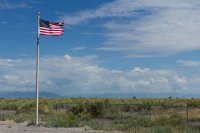
Standing below on the playa, hair and clothing sympathetically flapping on the gusts, I looked up at the stars and stripes. It's colors were clean and vibrant, unsullied, as if ignorant to the injustices which once took place here. A gold globe topping the tall pole reflected the afternoon sun like a beacon, radiant and shameless.
I toed the gravel, turning my eyes down from the flag. Despite the desert heat, an icy tremor rolled down my spine. This was Topaz.
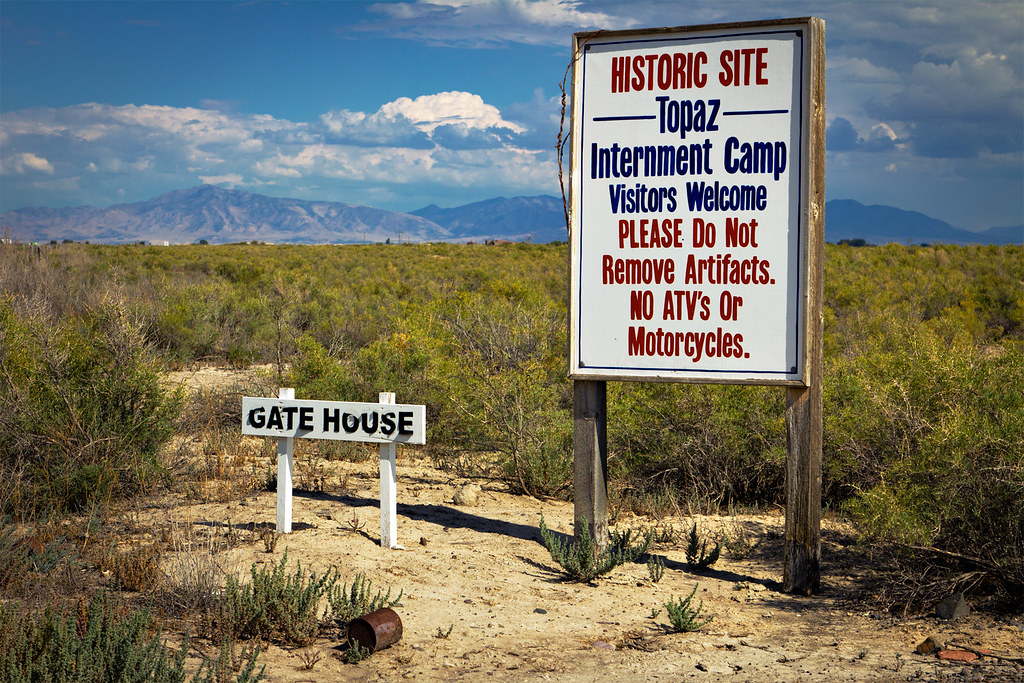
Topaz Internment Camp by ashergrey, on Flickr
The organized grid of hard-packed streets, devoid of tire tracks, leave much to the imagination. Look closer though and one can dissect the detritus of my people's hypocrisy. Rusted nails and smashed bits of ceramic surrounded stunted bushes like scattered seeds.
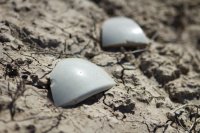
Looking across the plot, I tried to imagine it filled with tar-paper shacks and guard towers. I envisioned dust storms blowing east toward Delta.
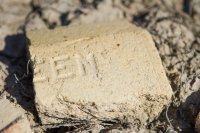
I imagined the sound of a solitary train whistle wailing mournfully across the desert.
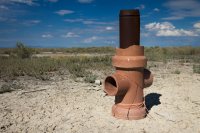
I pictured bundles of barbed wire unstrung along the perimeter, as if a bit of sharpened metal could really compare to the deadliness of the dry basins and distant mountain ranges beyond its boundary.
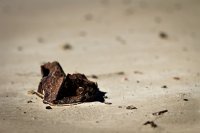
A brief afternoon's reflection spent sweating under the unrelenting sun bears no comparison to what the internees suffered here. I've heard it said Topaz is not worth the stop. It lacks visual punch. It lacks interpretive opportunities, such as a long-planned but under-financed museum. It's too far away and too hard to find for the car-tripping family out for an enjoyable holiday.
What a pathetic statement on we Americans as a people.
Unlike the people who once lived here against their collective wills through those wartime years, through frost-bitten winters and searing summers, I expressed my freedom. I left when I wanted. As the sun dipped toward the west, I climbed into my idling car and rocketed out west on U.S. 6.
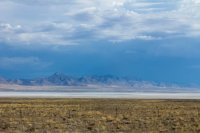
Oddities exist in Utah's hinterlands, both natural and constructed. Intergalactic communicators? Horribly-designed, oversized pin-wheels?
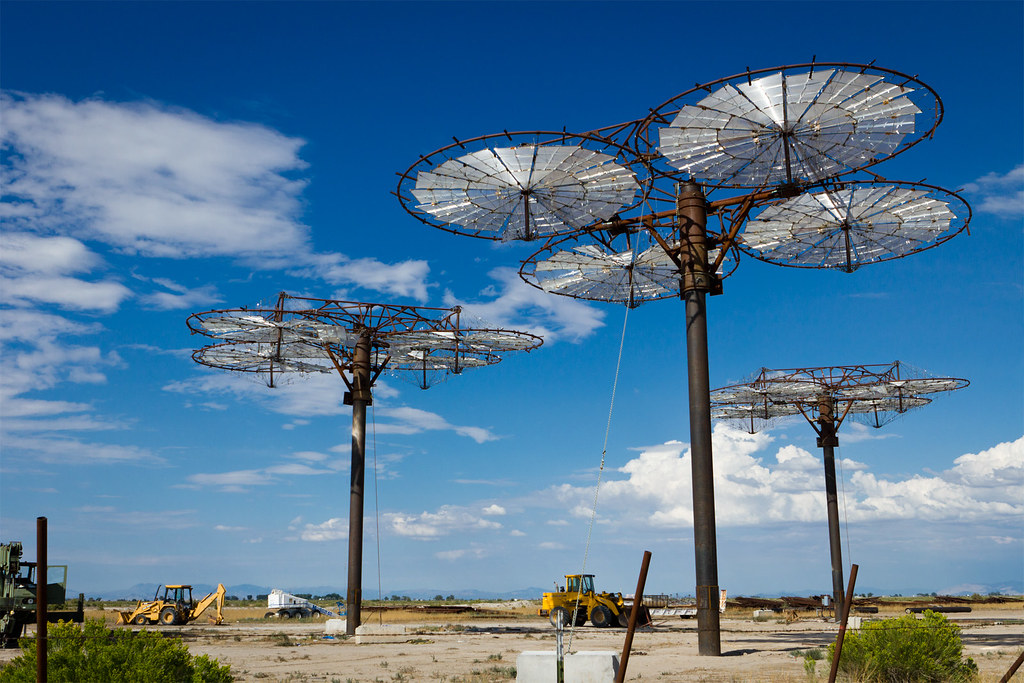
Delta by ashergrey, on Flickr
No. Utah tends to breed scams and it appears these might well be part of yet another one.
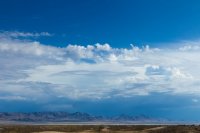
Gathering clouds over the dry Sevier Lake bed warned of what was to come after Topaz. As my wheels rolled westward toward Wheeler Peak, the roiling skies made clear their intent.
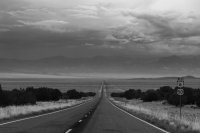
Even on a three-day holiday weekend, it's possible to drive into Great Basin National Park and find vacancies. Try that in Zion. I drove up the Wheeler Peak Scenic Road and rolled into the campground a bit before dusk. A few open spots remained and I pulled into one. Everything there held the damp of recent rain, ruling out a campfire. I sat and read awhile before fixing dinner next to my car at 10,000 feet.
Cold rain showers unleashed at dusk. After a brief jaunt through the misty forest to stretch my legs, I settled in for a night in the back of the wagon.
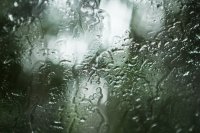
It rained through the night but morning broke Sunday with a crispness to the alpine air. From deep within the shadows of the evergreens, I stopped to watch as shafts of golden light filtered through the boughs.
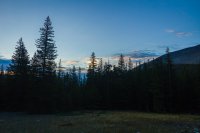
While hiking the short Stella-Teresa Lakes loop, Wheeler's blunt north face came aglow.
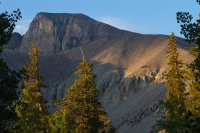
The voices of peak-baggers up on the ridge carried on the thin air.
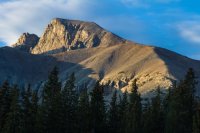
My own pulse pounded in the ears, protesting the altitude.
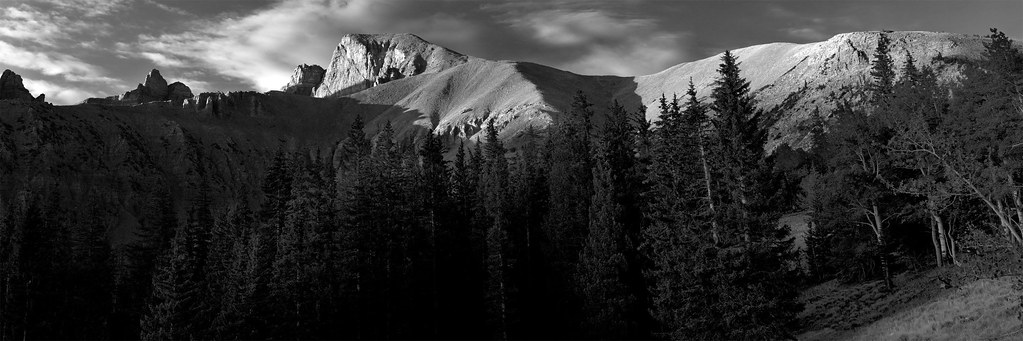
Wheeler pano by ashergrey, on Flickr
Then, rounding a corner, I broke out onto the one scene that seems to justify this little backwater park's existence. The fidelity of the reflection stunned my senses. Stella's water smooth as liquid mercury reflected the scene.
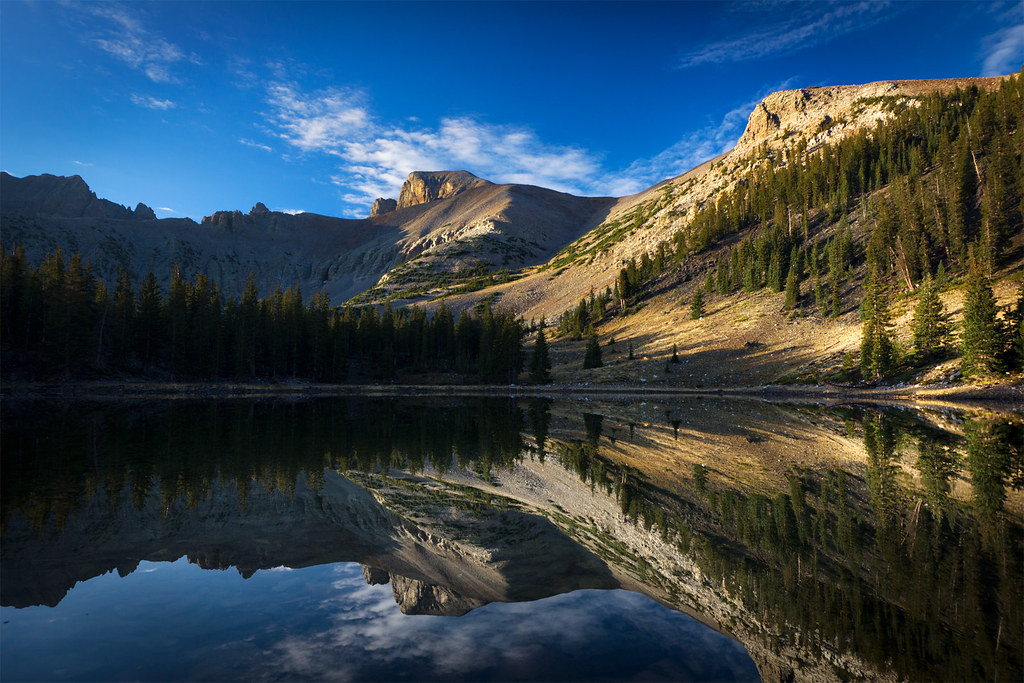
Wheeler Peak Reflection by ashergrey, on Flickr
The air, hanging perfectly still, made it seem as if the earth had decided to hold its breath. I worked around the lake's north shore, experimenting with angles and compositions. As the sun climbed, the scene gradually lost its splendor.
Campers were just coming awake at the campground as I strolled back onto the asphalt. After breakfast, I shook off the rain pooled on my belongings and headed down the mountain.
People were just starting to mull around the Lehman Caves visitor center. With my "handheld" camera in hand (and a large flash head bulging out of my cargo pocket) and joined a group headed in for the Grand Palace tour.
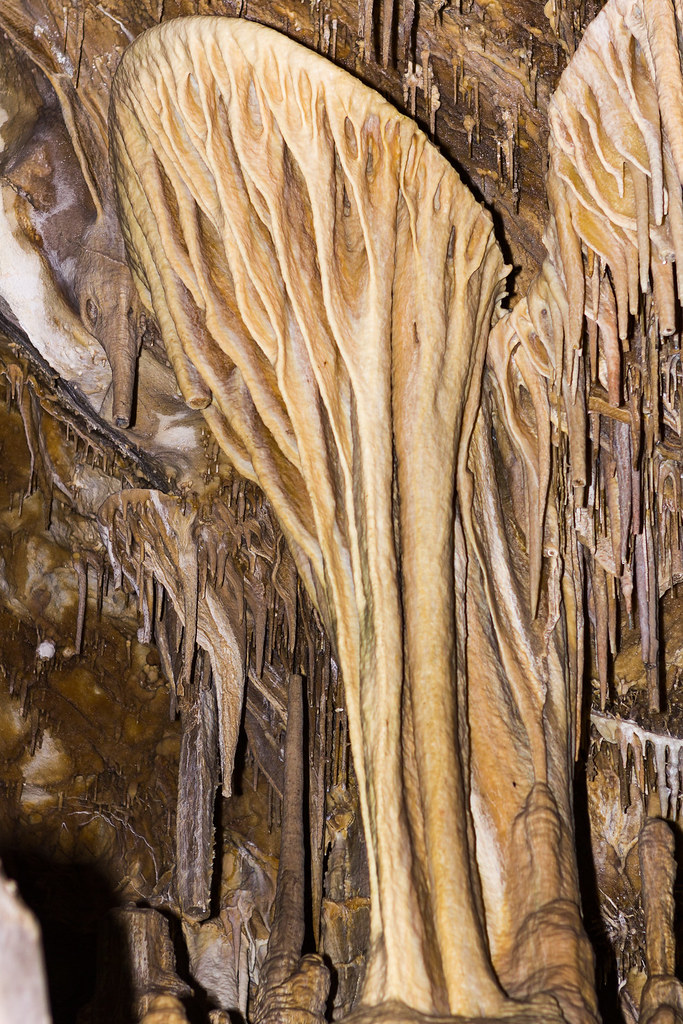
Shield by ashergrey, on Flickr
Unsurprisingly, tripods are not welcome on these general purpose tours. Shooting decent photos on the move in the low-light conditions proves incredibly difficult.
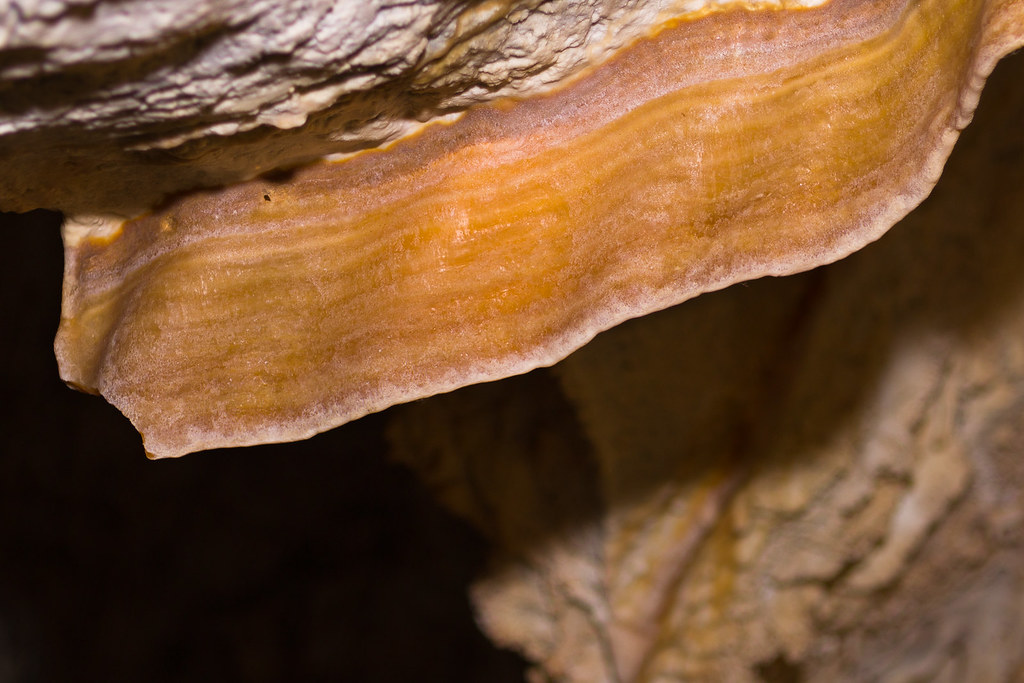
Cave Bacon by ashergrey, on Flickr
Even with the focus-assist beam on the flash I found many shots came out quite soft. The on-axis light also proves highly unflattering.
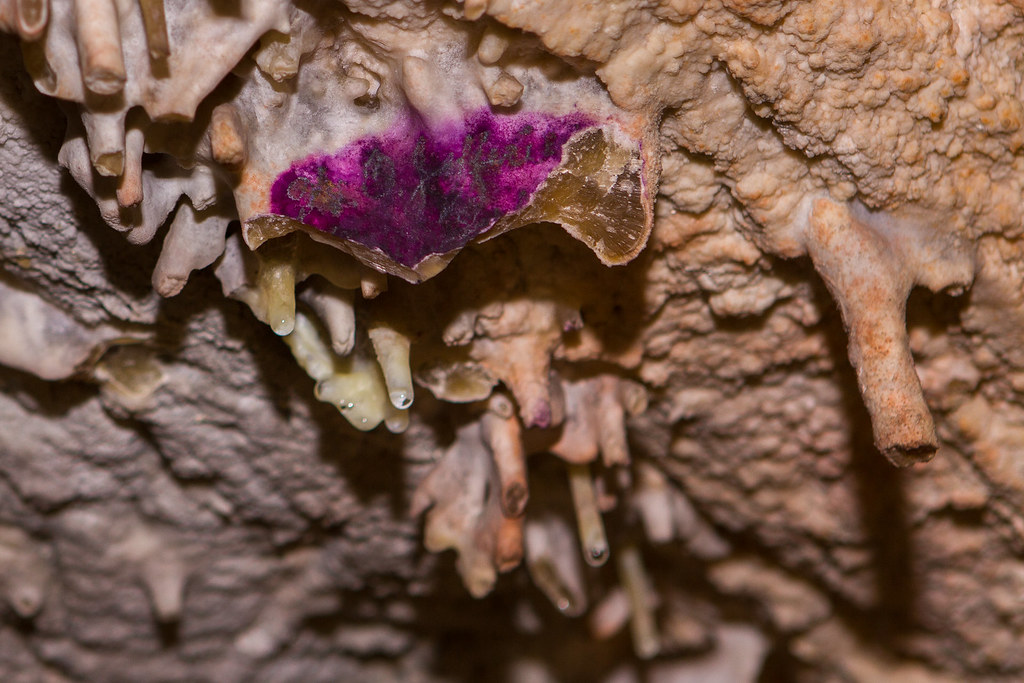
Purple by ashergrey, on Flickr
Attempting to bounce it didn't help much. My best shots out of the tour were of smaller details.
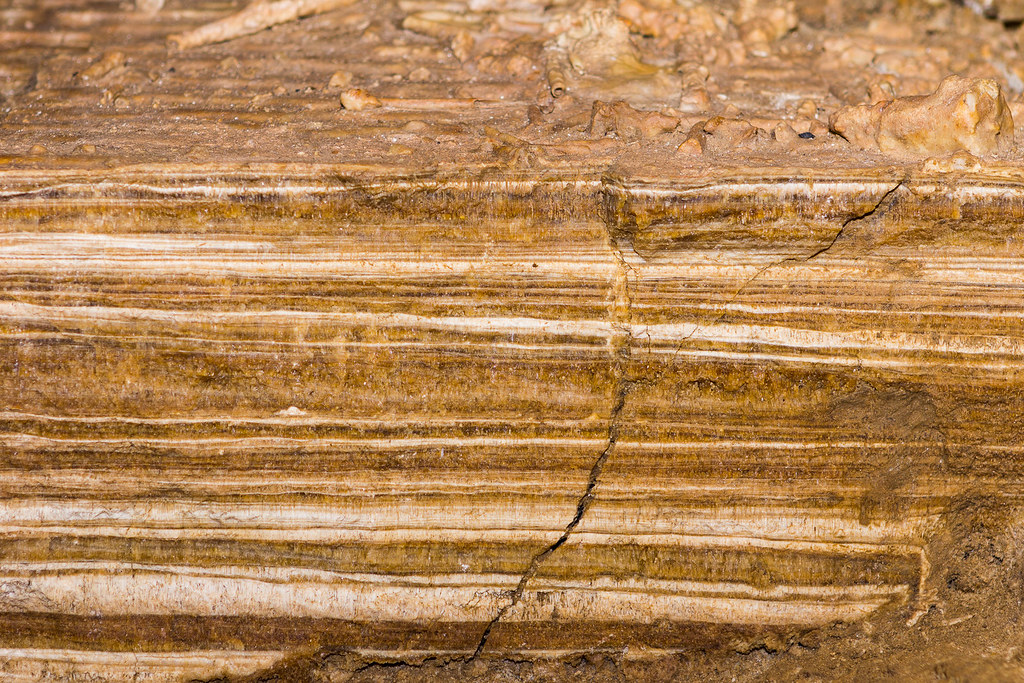
Lehman Stripes by ashergrey, on Flickr
The interpretive ranger pointed out a number of interesting items of note. She hadn't ever noticed this apparently split column until I showed her.
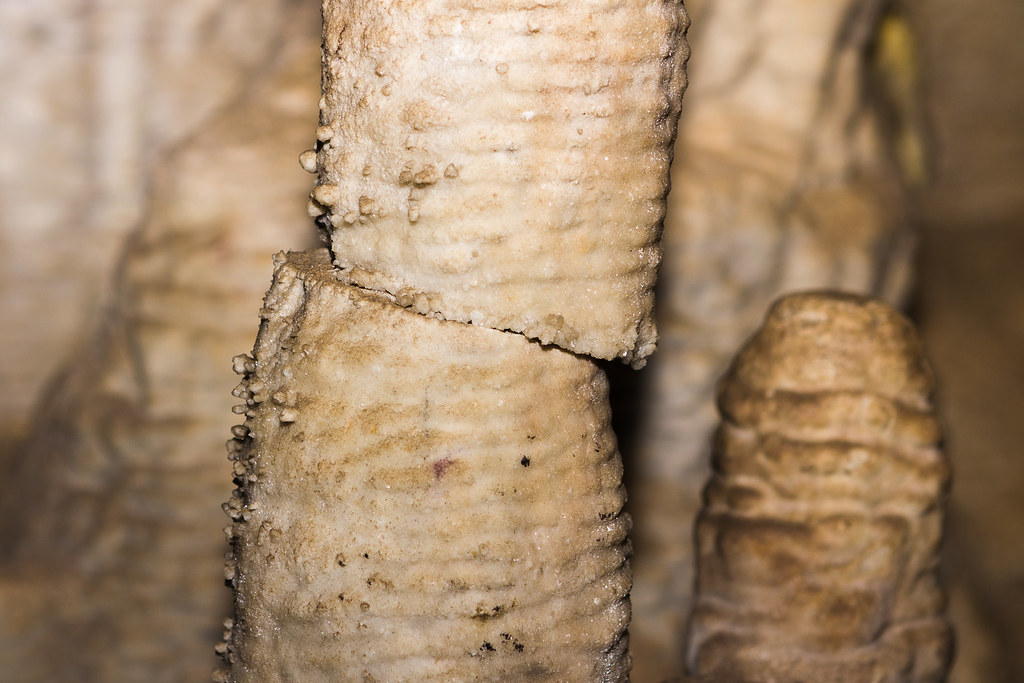
Split by ashergrey, on Flickr
At one point in the tour, the ranger asked which other caves the participants had entered. To my surprise, none of the other visitors mentioned Timpanogos. When I brought it up, the ranger seemed genuinely interested in knowing how Timp compared to Lehman. By my estimation, I told her Timpanogos was wetter.
I didn't bother to mention it's also prettier. It seemed like bad form.
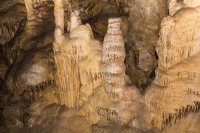
Strolling the Lehman Caves visitor center afterward, it surprised me to see books about Topaz on the shelves. The Great Basin has a way of both expanding and shrinking topography. The internment camp, some 100 miles distant by highway, still counts as a local point of interest at the park. I presume this is because there's little between them but Notch Peak and a whole lot of desert.
Having camped at an established campground and taken part in an organized tour, I felt every bit the tourist. The part of me that yearns for isolation wanted out, so I picked up an optional backpacking permit from the visitor center before heading to the Baker Lake trailhead.
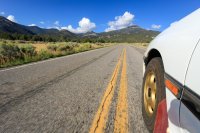
Grasshoppers flipped lazily before my boots and the obnoxious crackle of cicadas filled the air as I started up the path. The trail starts at roughly 8,000 feet ASL, but the terrain looks more like what one would expect to see around 5,000 feet ASL along the Wasatch Front. Vegetation is low, scrubby and very desert-ish. A small stream teases the hiker at the outset. It runs right near the trailhead, but the trail veers away from it immediately as it switchbacks up the north side of the drainage.
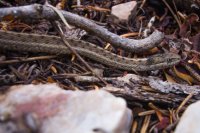
The two do rejoin after hikers pass out of the desert altitude zones. The brushy foliage gradually gives way to isolated stands of aspen before plunging into old-growth evergreen forest. Hiking through the transition is almost jarring. Sweat-leeching heat gives way to mossy humidity. The dusty path turns muddy as rivulets from snow-fed springs trickle down into Baker Creek.
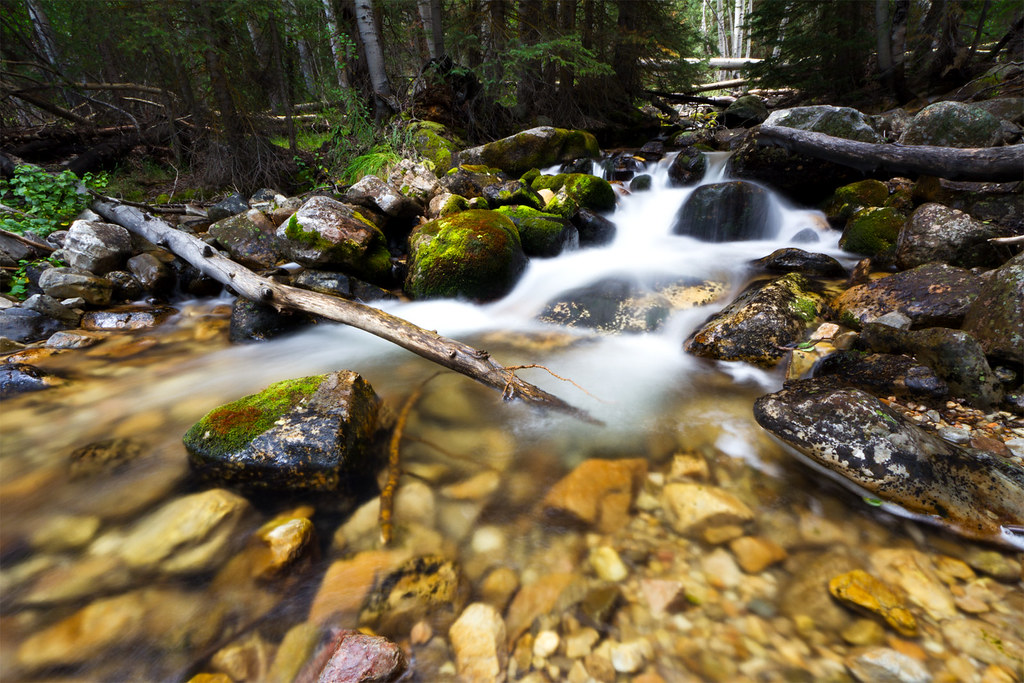
Baker Creek by ashergrey, on Flickr
Unfortunately, experiencing this transition means hiking a constant ramp up 2,500 vertical feet. The trail literally has no break. It is a non-stop ascent with no flat stretches at which to catch one's breath. The elevation profile from my hike seems to indicate there's a break at about the two-mile mark — don't believe it. That only occurs because I took a diversion and crossed briefly over into the neighboring South Fork of Baker drainage.

The longer I hiked, the thicker the clouds grew overhead. My hair slicked with moisture. The humidity had crept up to the point that sweat no longer seemed to evaporate from off my skin.
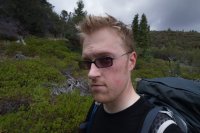
Still the trail climbed, much to the protestation of my aching thighs and shoulders. In switchbacks and long straightaways, the way went ever upward.

As the trees started to thin, rain showers began weeping over the mountains. Ducking under pines where possible, I came to realize why parts of the trail were choked by high grasses. Clouds pushing east over the spine of the range must constantly spit moisture down onto the thirsty slopes.
Up toward tree line, wide fields of toppled lumber bore grim testament to the amount of snow the alpine zone here carries during the winter. Signs of avalanche activity and extreme weathering abound.
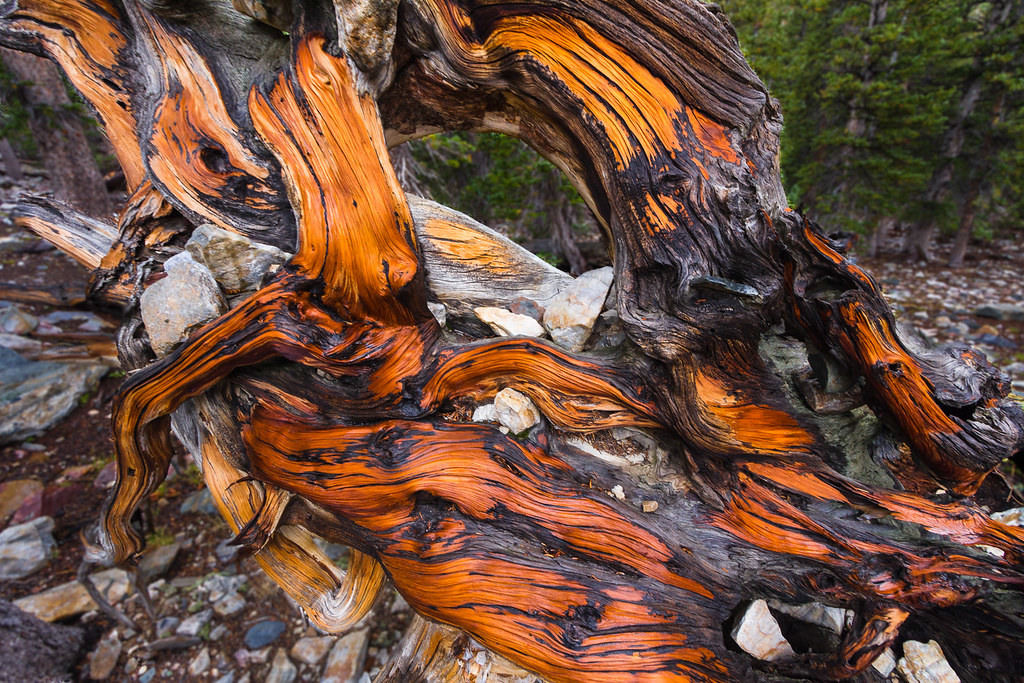
Twisted by ashergrey, on Flickr
Arriving at last at Baker Lake, I found it utterly deserted.
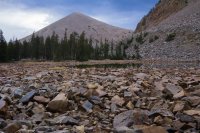
Moist and chilled, I unshouldered my pack and scouted out a campsite along the lake's northern shore. A stand of tall pines provided perfect spacing for my hammock. This trip was to be my first with a new, ultra-lightweight OES sil-nylon cat-cut tarp.
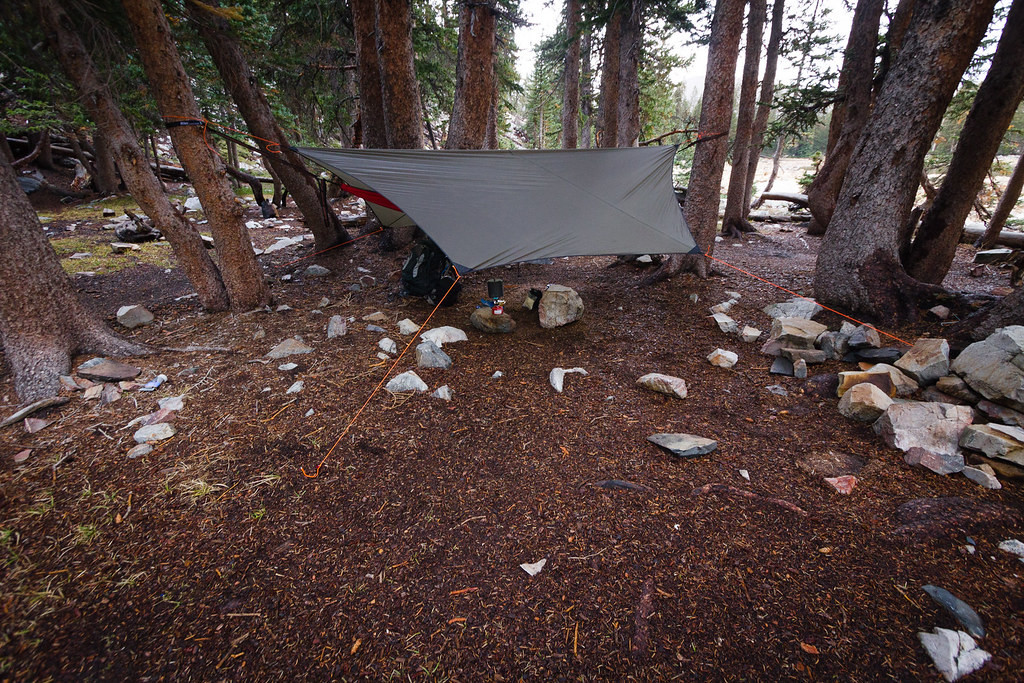
Baker Lake camp by ashergrey, on Flickr
No sooner had I set camp than rain intensified. Wind made my stove sputter until I built a shield out of flat rocks. Hiding out beneath the thin sheet of nylon, I questioned myself again as to why I made hiking my hobby. Surely there are more enjoyable ways to spend your time. Thunder rumbled as the air grew ever colder.
There was no sunset that night, just a gradual deepening darkness. Clouds blotted out the sky from horizon to horizon. Being very near to the new moon, the night bore an intense blackness that in the absence of stars seemed smothering.
Night fell. Then the wind started. Tree limbs loaded with chilled drops shuddered and shed their weight. Gusts blowing through the forest had the sound of crashing surf. I climbed into the hammock under the sheet of taught nylon and tried to read for a time. It became too uncomfortable keep an arm out holding the book so I switched off my head lamp and attempted to sleep.
Noises in the dark wormed into my ears and psyche. The wind whispered warnings about staying out of sight, bundled in a nylon bag filled with fluffy feathers. Who knows what creatures stalk these woods on a moonless night?
All about the trees swooshed and swayed. Light patters of rain hit the taught tarp in waves, sounding like tacks dropped on a snare drum. Huddled down in the hammock, I tried to block out the gale. An hour passed. Still the wind would not relent. In some moments it would seem to stop, easing its shaking of the tarp. Then, in the distance, I'd hear a rush through the pines and against the rocks. That sound, rising in pitch like the Doppler shriek of an approaching locomotive, would slam into my thin shelter with renewed force.
One particularly strong bout wrenched at just the right angle and succeeded in tearing the tarp free. It inflated it like a parachute. The edges of it flapped with the furor of a drowning swimmer. My face, now fully exposed to the stinging cold, contorted in shock. Little flecks of rain like spittle hit my skin. I couldn't see the tarp billowing madly just inches from me in the blackness. Fearing it would blow completely away, I groped into the darkness before me. The slick fabric swarmed between my hands so I wrapped my arms around it. Finding one of the frayed guy lines with my fingers, I pulled it taught over my head. The hexagonal sheet smoothed and though it still shuddered with the wind, the worst of its tremors subsided.
While still holding the synthetic fabric tight, I spared a hand to to find my head lamp. When clicked on its blue-white beam overwhelmed my dilated pupils. As they adjusted to the light I saw with relief that only one of the six guy lines — the one running over my head — had broken.
At this point I knew I had only one choice. I had to refasten the line.
Swinging my feet over the side of the hammock, I dropped into a pair of sandals. Wearing only them and a thin pair of nylon boxers, I went to work. The moving air made my naked skin clammy. Fingers made knobby by the cold pulled hard on the line, wrapping it back around the tree's sap-coated trunk. Fragrant pine pitch gummed up my touch like sticky candy on the hands of a child. The headlamp cast only a cone of light, leaving my back exposed to the blackness.
Please don't allow any prowling predator to see this.
Improvising a knot I hoped would hold the night, I finished my hasty work and crawled back into bed.
Morning came at last with promise of relief. As the sun clawed its way up from the east, I cracked an eye to see the overcast starting to lift. Wind still swirled through the Baker Lake basin but it too came with diminished fury.
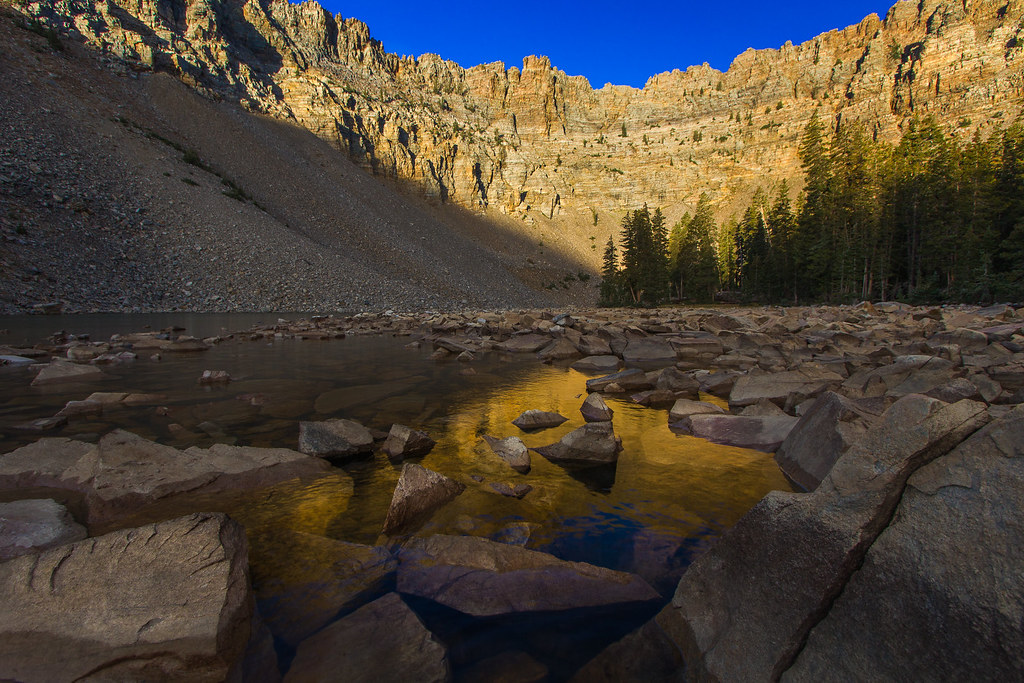
Baker Lake by ashergrey, on Flickr
With the bad night behind me, I hopped over rocks and snapped some pictures in the sharp morning air.
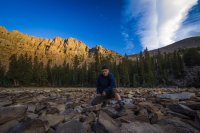
I'd planned to cross over a high shoulder to the south, descending by Johnson Lake to make a loop of the hike. However, that plan changed when a strong gust of wind toppled my camera. Like a last insult slung in an argument, the night's fowl weather reached out and knocked the device into the drink. I heard it hit the surface of Baker Lake with a splash from a few feet away, where I stood with a remote shutter release.
I retrieved it in a matter of seconds but the damage had been done. Detaching the lens, I watched in horror as lake water poured out of the mirror assembly. I shook the parts in fury, trying to free them of moisture. No dice.
Frustrated at having carted this camera through far more watery locales than this without incident, I hastily broke camp and started stamping my way back down the incline to the trailhead.
[PARSEHTML]<iframe src="http://www.mappingsupport.com/p/gmap4.php?q=https://dl.dropboxusercontent.com/u/3847512/GPS/Baker_Lake.kml&t=t4" frameborder="0" marginheight="0" scrolling="no" width="800" height="800"></iframe><br><br>[/PARSEHTML]Featured image for home page:
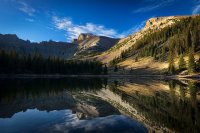

Standing below on the playa, hair and clothing sympathetically flapping on the gusts, I looked up at the stars and stripes. It's colors were clean and vibrant, unsullied, as if ignorant to the injustices which once took place here. A gold globe topping the tall pole reflected the afternoon sun like a beacon, radiant and shameless.
I toed the gravel, turning my eyes down from the flag. Despite the desert heat, an icy tremor rolled down my spine. This was Topaz.

Topaz Internment Camp by ashergrey, on Flickr
The organized grid of hard-packed streets, devoid of tire tracks, leave much to the imagination. Look closer though and one can dissect the detritus of my people's hypocrisy. Rusted nails and smashed bits of ceramic surrounded stunted bushes like scattered seeds.

Looking across the plot, I tried to imagine it filled with tar-paper shacks and guard towers. I envisioned dust storms blowing east toward Delta.

I imagined the sound of a solitary train whistle wailing mournfully across the desert.

I pictured bundles of barbed wire unstrung along the perimeter, as if a bit of sharpened metal could really compare to the deadliness of the dry basins and distant mountain ranges beyond its boundary.

A brief afternoon's reflection spent sweating under the unrelenting sun bears no comparison to what the internees suffered here. I've heard it said Topaz is not worth the stop. It lacks visual punch. It lacks interpretive opportunities, such as a long-planned but under-financed museum. It's too far away and too hard to find for the car-tripping family out for an enjoyable holiday.
What a pathetic statement on we Americans as a people.
Unlike the people who once lived here against their collective wills through those wartime years, through frost-bitten winters and searing summers, I expressed my freedom. I left when I wanted. As the sun dipped toward the west, I climbed into my idling car and rocketed out west on U.S. 6.

Oddities exist in Utah's hinterlands, both natural and constructed. Intergalactic communicators? Horribly-designed, oversized pin-wheels?

Delta by ashergrey, on Flickr
No. Utah tends to breed scams and it appears these might well be part of yet another one.

Gathering clouds over the dry Sevier Lake bed warned of what was to come after Topaz. As my wheels rolled westward toward Wheeler Peak, the roiling skies made clear their intent.

Even on a three-day holiday weekend, it's possible to drive into Great Basin National Park and find vacancies. Try that in Zion. I drove up the Wheeler Peak Scenic Road and rolled into the campground a bit before dusk. A few open spots remained and I pulled into one. Everything there held the damp of recent rain, ruling out a campfire. I sat and read awhile before fixing dinner next to my car at 10,000 feet.
Cold rain showers unleashed at dusk. After a brief jaunt through the misty forest to stretch my legs, I settled in for a night in the back of the wagon.

It rained through the night but morning broke Sunday with a crispness to the alpine air. From deep within the shadows of the evergreens, I stopped to watch as shafts of golden light filtered through the boughs.

While hiking the short Stella-Teresa Lakes loop, Wheeler's blunt north face came aglow.

The voices of peak-baggers up on the ridge carried on the thin air.

My own pulse pounded in the ears, protesting the altitude.

Wheeler pano by ashergrey, on Flickr
Then, rounding a corner, I broke out onto the one scene that seems to justify this little backwater park's existence. The fidelity of the reflection stunned my senses. Stella's water smooth as liquid mercury reflected the scene.

Wheeler Peak Reflection by ashergrey, on Flickr
The air, hanging perfectly still, made it seem as if the earth had decided to hold its breath. I worked around the lake's north shore, experimenting with angles and compositions. As the sun climbed, the scene gradually lost its splendor.
Campers were just coming awake at the campground as I strolled back onto the asphalt. After breakfast, I shook off the rain pooled on my belongings and headed down the mountain.
People were just starting to mull around the Lehman Caves visitor center. With my "handheld" camera in hand (and a large flash head bulging out of my cargo pocket) and joined a group headed in for the Grand Palace tour.

Shield by ashergrey, on Flickr
Unsurprisingly, tripods are not welcome on these general purpose tours. Shooting decent photos on the move in the low-light conditions proves incredibly difficult.

Cave Bacon by ashergrey, on Flickr
Even with the focus-assist beam on the flash I found many shots came out quite soft. The on-axis light also proves highly unflattering.

Purple by ashergrey, on Flickr
Attempting to bounce it didn't help much. My best shots out of the tour were of smaller details.

Lehman Stripes by ashergrey, on Flickr
The interpretive ranger pointed out a number of interesting items of note. She hadn't ever noticed this apparently split column until I showed her.

Split by ashergrey, on Flickr
At one point in the tour, the ranger asked which other caves the participants had entered. To my surprise, none of the other visitors mentioned Timpanogos. When I brought it up, the ranger seemed genuinely interested in knowing how Timp compared to Lehman. By my estimation, I told her Timpanogos was wetter.
I didn't bother to mention it's also prettier. It seemed like bad form.

Strolling the Lehman Caves visitor center afterward, it surprised me to see books about Topaz on the shelves. The Great Basin has a way of both expanding and shrinking topography. The internment camp, some 100 miles distant by highway, still counts as a local point of interest at the park. I presume this is because there's little between them but Notch Peak and a whole lot of desert.
Having camped at an established campground and taken part in an organized tour, I felt every bit the tourist. The part of me that yearns for isolation wanted out, so I picked up an optional backpacking permit from the visitor center before heading to the Baker Lake trailhead.

Grasshoppers flipped lazily before my boots and the obnoxious crackle of cicadas filled the air as I started up the path. The trail starts at roughly 8,000 feet ASL, but the terrain looks more like what one would expect to see around 5,000 feet ASL along the Wasatch Front. Vegetation is low, scrubby and very desert-ish. A small stream teases the hiker at the outset. It runs right near the trailhead, but the trail veers away from it immediately as it switchbacks up the north side of the drainage.

The two do rejoin after hikers pass out of the desert altitude zones. The brushy foliage gradually gives way to isolated stands of aspen before plunging into old-growth evergreen forest. Hiking through the transition is almost jarring. Sweat-leeching heat gives way to mossy humidity. The dusty path turns muddy as rivulets from snow-fed springs trickle down into Baker Creek.

Baker Creek by ashergrey, on Flickr
Unfortunately, experiencing this transition means hiking a constant ramp up 2,500 vertical feet. The trail literally has no break. It is a non-stop ascent with no flat stretches at which to catch one's breath. The elevation profile from my hike seems to indicate there's a break at about the two-mile mark — don't believe it. That only occurs because I took a diversion and crossed briefly over into the neighboring South Fork of Baker drainage.
The longer I hiked, the thicker the clouds grew overhead. My hair slicked with moisture. The humidity had crept up to the point that sweat no longer seemed to evaporate from off my skin.

Still the trail climbed, much to the protestation of my aching thighs and shoulders. In switchbacks and long straightaways, the way went ever upward.

As the trees started to thin, rain showers began weeping over the mountains. Ducking under pines where possible, I came to realize why parts of the trail were choked by high grasses. Clouds pushing east over the spine of the range must constantly spit moisture down onto the thirsty slopes.
Up toward tree line, wide fields of toppled lumber bore grim testament to the amount of snow the alpine zone here carries during the winter. Signs of avalanche activity and extreme weathering abound.

Twisted by ashergrey, on Flickr
Arriving at last at Baker Lake, I found it utterly deserted.

Moist and chilled, I unshouldered my pack and scouted out a campsite along the lake's northern shore. A stand of tall pines provided perfect spacing for my hammock. This trip was to be my first with a new, ultra-lightweight OES sil-nylon cat-cut tarp.

Baker Lake camp by ashergrey, on Flickr
No sooner had I set camp than rain intensified. Wind made my stove sputter until I built a shield out of flat rocks. Hiding out beneath the thin sheet of nylon, I questioned myself again as to why I made hiking my hobby. Surely there are more enjoyable ways to spend your time. Thunder rumbled as the air grew ever colder.
There was no sunset that night, just a gradual deepening darkness. Clouds blotted out the sky from horizon to horizon. Being very near to the new moon, the night bore an intense blackness that in the absence of stars seemed smothering.
Night fell. Then the wind started. Tree limbs loaded with chilled drops shuddered and shed their weight. Gusts blowing through the forest had the sound of crashing surf. I climbed into the hammock under the sheet of taught nylon and tried to read for a time. It became too uncomfortable keep an arm out holding the book so I switched off my head lamp and attempted to sleep.
Noises in the dark wormed into my ears and psyche. The wind whispered warnings about staying out of sight, bundled in a nylon bag filled with fluffy feathers. Who knows what creatures stalk these woods on a moonless night?
All about the trees swooshed and swayed. Light patters of rain hit the taught tarp in waves, sounding like tacks dropped on a snare drum. Huddled down in the hammock, I tried to block out the gale. An hour passed. Still the wind would not relent. In some moments it would seem to stop, easing its shaking of the tarp. Then, in the distance, I'd hear a rush through the pines and against the rocks. That sound, rising in pitch like the Doppler shriek of an approaching locomotive, would slam into my thin shelter with renewed force.
One particularly strong bout wrenched at just the right angle and succeeded in tearing the tarp free. It inflated it like a parachute. The edges of it flapped with the furor of a drowning swimmer. My face, now fully exposed to the stinging cold, contorted in shock. Little flecks of rain like spittle hit my skin. I couldn't see the tarp billowing madly just inches from me in the blackness. Fearing it would blow completely away, I groped into the darkness before me. The slick fabric swarmed between my hands so I wrapped my arms around it. Finding one of the frayed guy lines with my fingers, I pulled it taught over my head. The hexagonal sheet smoothed and though it still shuddered with the wind, the worst of its tremors subsided.
While still holding the synthetic fabric tight, I spared a hand to to find my head lamp. When clicked on its blue-white beam overwhelmed my dilated pupils. As they adjusted to the light I saw with relief that only one of the six guy lines — the one running over my head — had broken.
At this point I knew I had only one choice. I had to refasten the line.
Swinging my feet over the side of the hammock, I dropped into a pair of sandals. Wearing only them and a thin pair of nylon boxers, I went to work. The moving air made my naked skin clammy. Fingers made knobby by the cold pulled hard on the line, wrapping it back around the tree's sap-coated trunk. Fragrant pine pitch gummed up my touch like sticky candy on the hands of a child. The headlamp cast only a cone of light, leaving my back exposed to the blackness.
Please don't allow any prowling predator to see this.
Improvising a knot I hoped would hold the night, I finished my hasty work and crawled back into bed.
Morning came at last with promise of relief. As the sun clawed its way up from the east, I cracked an eye to see the overcast starting to lift. Wind still swirled through the Baker Lake basin but it too came with diminished fury.

Baker Lake by ashergrey, on Flickr
With the bad night behind me, I hopped over rocks and snapped some pictures in the sharp morning air.

I'd planned to cross over a high shoulder to the south, descending by Johnson Lake to make a loop of the hike. However, that plan changed when a strong gust of wind toppled my camera. Like a last insult slung in an argument, the night's fowl weather reached out and knocked the device into the drink. I heard it hit the surface of Baker Lake with a splash from a few feet away, where I stood with a remote shutter release.
I retrieved it in a matter of seconds but the damage had been done. Detaching the lens, I watched in horror as lake water poured out of the mirror assembly. I shook the parts in fury, trying to free them of moisture. No dice.
Frustrated at having carted this camera through far more watery locales than this without incident, I hastily broke camp and started stamping my way back down the incline to the trailhead.
[PARSEHTML]<iframe src="http://www.mappingsupport.com/p/gmap4.php?q=https://dl.dropboxusercontent.com/u/3847512/GPS/Baker_Lake.kml&t=t4" frameborder="0" marginheight="0" scrolling="no" width="800" height="800"></iframe><br><br>[/PARSEHTML]Featured image for home page:

